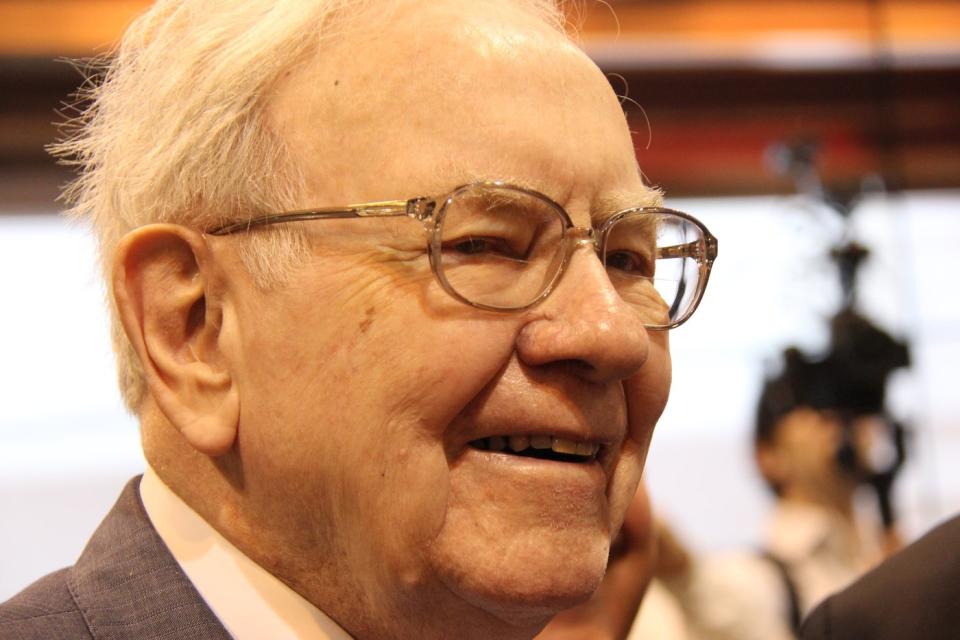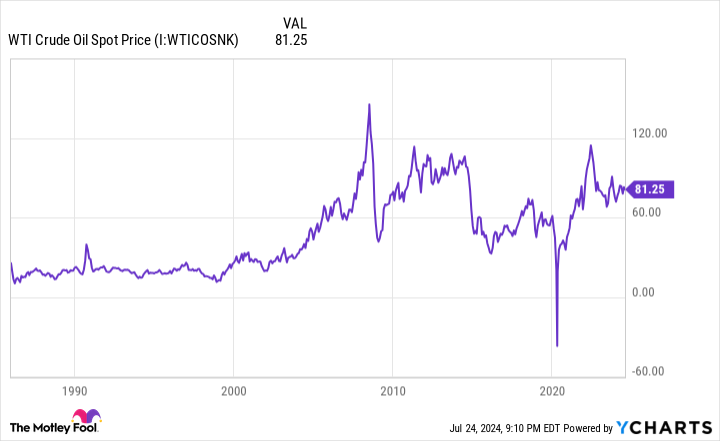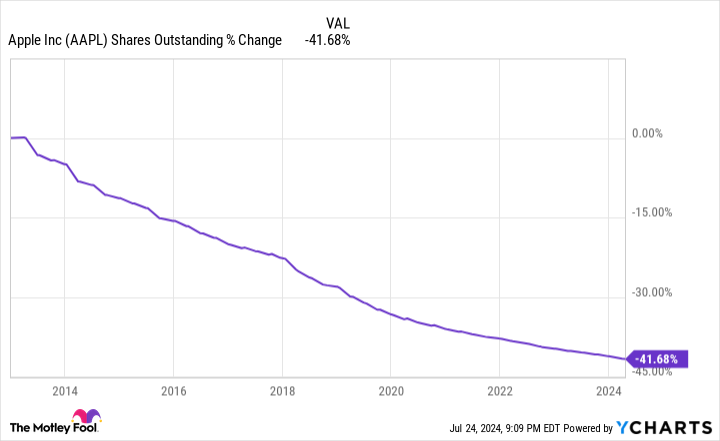Few billionaire money managers garner attention on Wall Street like Warren Buffett. Since the affably named “Oracle of Omaha” became CEO of Berkshire Hathaway (NYSE: BRK.A)(NYSE: BRK.B) in 1965, he’s overseen a greater-than-5,200,000% aggregate return in his company’s Class A shares (BRK.A). This works out to a near-doubling of the S&P 500‘s annualized total return, including dividends, spanning almost six decades.
Although lengthy books have been written outlining the strategies Buffett uses to build wealth on Wall Street, his greatest advantage might be his love for dividend stocks.

Last year, the investment advisors at Hartford Funds published a report that examined the numerous ways dividend stocks have outperformed non-payers over the last 50 years (1973-2023). In particular, “The Power of Dividends: Past, Present and Future” showed that dividend stocks more than doubled the average annual return of non-payers over a half-century (9.17% vs. 4.27%), and did so while exhibiting less volatility than the benchmark S&P 500.
Companies that regularly dole out a percentage of their earnings to shareholders are often profitable on a recurring basis, time-tested, and capable of providing transparent growth outlooks. In short, this is the blueprint we’d expect of businesses that’ll increase in value over the long run.
Though a majority of the 44 stocks in Berkshire Hathaway’s $399 billion portfolio pay a dividend, just seven holdings are on track to collectively account for $5.26 billion in annual dividend income.
1. Bank of America: $1,038,919,522 in annual dividend income
Despite Buffett and his top aides selling nearly 33.9 million shares of Bank of America (NYSE: BAC) stock last week, Berkshire’s No. 2 holding by market value is its dividend king. With BofA increasing its dividend by $0.02 per share following the latest round of Fed stress tests, Berkshire is on pace to collect almost $1.04 billion in dividend income from its nearly 999 million-share stake in Bank of America over the next 12 months.
What’s made Bank of America such a fantastic stock to own in recent years is its sensitivity to interest rates. No money-center bank will see its net-interest income shift more when interest rates change. The Fed’s most-aggressive rate-hiking cycle in four decades, which began in March 2022, has been a big lift to the company’s bottom line.
BofA’s digitization efforts are impressive, as well. In the June-ended quarter, 77% of consumer households were banking digitally, with 53% of all loan sales completed online or via mobile app. Digital transactions are notably cheaper for banks than in-person interactions.
2. Occidental Petroleum: $903,767,741 (includes preferred stock dividend income)
One of Warren Buffett’s favorite stocks to buy since the start of 2022, integrated oil and gas stock Occidental Petroleum (NYSE: OXY), is Berkshire’s second-most-important dividend stock. The roughly 255.3 million shares of common stock owned will generate in the neighborhood of $224.6 million in annual dividend income. Meanwhile, $8.489 billion in Occidental preferred stock yielding 8% should provide another $679.1 million.
The interesting thing about Occidental Petroleum is that, despite being an integrated energy company that also has downstream chemical operations, it’s heavily reliant on its drilling operations for most of its revenue and operating cash flow. This means it can disproportionately benefit, relative to its peers, when the price of crude oil is climbing. The reciprocal is also true (i.e., disproportionate pain) when energy commodity prices are falling.
The good news for Occidental is that capital investment by global energy majors was slashed for three years during the COVID-19 pandemic. This has led to a tight oil supply worldwide, which is buoying the spot price of crude oil.
3. Chevron: $801,830,950
Big oil stocks are often known for their robust capital-return programs, and Chevron (NYSE: CVX) is no exception. Its board approved a $75 billion share-buyback program in January 2023 and gave the green light for its 37th consecutive annual dividend hike earlier this year. If Berkshire’s stake in Chevron remains static, it’ll collect north of $800 million in dividend income over the next 12 months.
While the catalysts for Chevron and Occidental are extremely similar, there are some identifiable differences between these two energy titans. For one, Chevron is a true integrated energy operator. Although its best margins derive from its upstream drilling segment, Chevron generates more than half of its collective sales from its transmission pipelines, refineries, and chemical plants. Chevron is well-hedged in the event that the spot price of crude oil falls.
Furthermore, it has what’s arguably the best balance sheet among global energy majors. It closed out the March quarter with a net debt ratio of only 8.8%, which gives it the financial flexibility to make acquisitions and expand its asset reserves.
4. Apple: $789,368,450
Not surprisingly, the largest position in Berkshire Hathaway’s investment portfolio is also a meaningful dividend payer. Tech-stock Apple (NASDAQ: AAPL), which makes up more than 43% of Berkshire’s $399 billion of invested assets, is expected to dole out $0.25/quarter over the next year. For Buffett’s company, this means more than $789 million in annual dividend income.
Innovation has been the driving force behind Apple’s climb to a valuation in excess of $3 trillion. In addition to being the most-chosen smartphone brand in the U.S., Apple is in the process of transforming into a platforms-based company. CEO Tim Cook is spearheading this evolution that should see margins improve over time. Further, a subscription-focused model can smooth out the sales fluctuations that typically coincide with major iPhone upgrade cycles.
Buffett is also a huge fan of Apple’s capital-return program. Aside from increasing its dividend on a fairly regular basis, Apple has repurchased $674 billion worth of its common stock since initiating a buyback program in 2013. Retiring nearly 42% of its outstanding shares has been a big-time positive for the company’s earnings per share (EPS).


5. Coca-Cola: $776,000,000
Warren Buffett’s longest-held stock is also one of Berkshire Hathaway’s top dividend payers. Consumer staples giant Coca-Cola (NYSE: KO) has been a continuous holding for Buffett’s company since 1988. Not only is Buffett’s company expected to collect $776 million in dividend income over the next year from this position, but the yield relative to Berkshire’s cost basis in Coca-Cola stock is a jaw-dropping 60%!
Geographic diversity plays a big role in Coke’s success. It has more than two dozen brands generating in excess of $1 billion in annual sales and ongoing operations in every country, save for Cuba, North Korea, and Russia (following its invasion of Ukraine). This allows Coca-Cola to take advantage of faster organic-growth opportunities in emerging markets, while still falling back on the predictable cash flow generated from developed countries.
Coca-Cola’s brand power is another reason it’s such a rock-solid company. According to the recently released “Brand Footprint” report by Kantar, Coca-Cola’s brands were the most-purchased brand by consumers for a 12th consecutive year.
6. Kraft Heinz: $521,015,709
Though it’s arguably been one of Buffett’s worst investments in recent years, consumer-packaged foods and condiments company Kraft Heinz (NASDAQ: KHC) still dishes out a hearty dividend. Its $0.40/quarter payout will generate north of $521 million in annual dividend income for Buffett’s company.
If there’s a positive for Kraft Heinz, it’s that it sells a basic need good (food) and possesses a portfolio packed with dozens of brand-name packaged foods and condiments. Most businesses were hurt by the pandemic, but when people were forced to isolate, it helped boost interest in the company’s easy-to-prepare meals and snacks.
The big issue for Kraft Heinz is its balance sheet. It’s lugging around nearly $20 billion in long-term debt and over $30 billion in goodwill that it may never recoup. All the while, the selling volume for its products is declining amid a wave of higher prices. There isn’t going to be an easy way for the company to reignite sustained interest in its brands.
7. American Express: $424,509,960
Credit-services provider American Express (NYSE: AXP) is the seventh big dividend payer in Berkshire’s portfolio that, collectively with Bank of America, Occidental, Chevron, Apple, Coca-Cola, and Kraft Heinz, will help Buffett’s company rake in $5.26 billion in annual dividend income. AmEx, as American Express is more commonly known, has been a continuous holding in Berkshire’s investment portfolio since 1991.
The not-so-subtle secret to AmEx’s long-term success has been its willingness to participate from both sides of the transaction aisle. In the U.S., it’s the third-largest payment processor by credit card network purchase volume. It’s also a lender and provides consumers and businesses with branded credit cards. This allows American Express to generate fees from merchants for facilitating transactions, as well as annual fees and interest income from its cardholders.
Furthermore, AmEx has a knack for attracting affluent cardholders. Compared to the average consumer, the well-to-do are less likely to alter their spending habits or fail to pay their bills during minor economic disruptions.
Should you invest $1,000 in Bank of America right now?
Before you buy stock in Bank of America, consider this:
The Motley Fool Stock Advisor analyst team just identified what they believe are the 10 best stocks for investors to buy now… and Bank of America wasn’t one of them. The 10 stocks that made the cut could produce monster returns in the coming years.
Consider when Nvidia made this list on April 15, 2005… if you invested $1,000 at the time of our recommendation, you’d have $700,076!*
Stock Advisor provides investors with an easy-to-follow blueprint for success, including guidance on building a portfolio, regular updates from analysts, and two new stock picks each month. The Stock Advisor service has more than quadrupled the return of S&P 500 since 2002*.
*Stock Advisor returns as of July 22, 2024
Bank of America and American Express are advertising partners of The Ascent, a Motley Fool company. Sean Williams has positions in Bank of America. The Motley Fool has positions in and recommends Apple, Bank of America, Berkshire Hathaway, and Chevron. The Motley Fool recommends Kraft Heinz and Occidental Petroleum. The Motley Fool has a disclosure policy.
Warren Buffett Is Raking in $5.26 Billion in Annual Dividend Income From These 7 Stocks was originally published by The Motley Fool
Source Agencies




